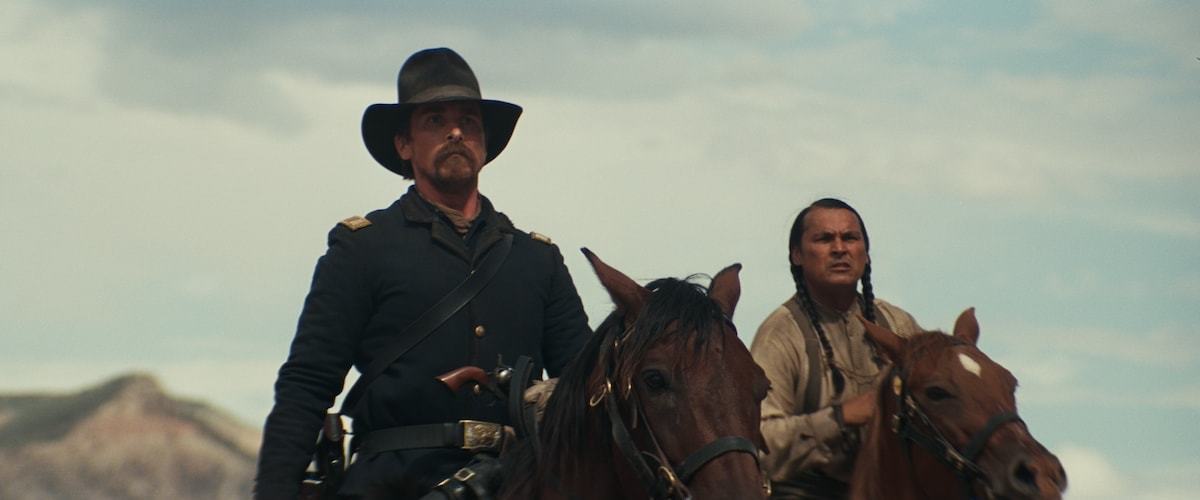Grade: C-
In their new Western “Hostiles,” Director Scott Cooper and
co writer Donald E. Stewart effectively deromanticize the American West and
depict it as a place of casual violence and conquest. During the opening scene,
set on a calm prairie out in the frontier, an unsuspecting homestead is
attacked by a band of quietly terrifying Commanches. Children, including an
infant are massacred with little fuss. Somehow, the movie only gets bleaker
from there. It’s overflowing with violence, death and suffering.
Through this extreme gloominess, “Hostiles” is primarily two
things: an exploration of the numbing, tormenting effect violence and suffering
can have on individuals over an extended period of time, as well as a somber, revisionist
look at the shameful legacy of white conquest in the old west. While
occasionally compelling, the film ultimately comes up short on both fronts. Cooper’s
narrative approach is disappointingly narrow-minded.
Our protagonist is Joseph Blocker, (Christian Bale) a US
army Captain who is broken down and full of hatred. Years of battle and death
have made him spiteful towards Native Americans. But that spite also masks an
aching feeling of guilt. This is perhaps the most pained, intense performance
Bale has delivered in his entire career. There’s no light or charisma in his
demeanor. The first time we see Blocker, in close up as he watches a trio of
Apaches being rounded up, he’s stiff and emotionless, dead inside.
Blocker is ready for retirement and maybe a hot bath. But
his work isn’t done yet. He’s ordered to escort an elderly Cheyenne chief named
Yellow Hawk (the great Wes Studi in another terrific, understated turn) and his
family back to their land in Montana. Blocker reluctantly agrees and they set
off, accompanied by a small cavalry unit. Along the way they encounter Rosalie
Quaid (Rosamund Pike) an emotionally fraught woman who lost her family in the
film’s opening attack, and face off against a diverse lot of antagonists
(Indians, fur trappers, land owners etc.).
Throughout the course of the journey, Blocker will take a
good hard look at his deep seeded hatred and guilt and perhaps even have a
change of heart about his Native acquaintances. By the middle of the second
act, “Hostiles” is dripping with white guilt, which is good. We have plenty to
feel guilty about regarding our despicable treatment of Native Americans (and
other minorities) in the old west and Cooper makes that very clear. In one
scene, one of Blockers men essentially apologizes to Yellow Hawk for the treatment
of his people. But this is also the main problem with “Hostiles:” despite its
good intentions the picture ultimately prioritizes white guilt and white
suffering at the expense of its Native characters.
This isn’t to say the film’s depiction of Native Americans
is entirely offensive. In fact Studi portrays Yellow Hawk as stoic and
enlightened. He’s generous even when his white counterparts don’t return the favor
and constantly preaches unity when the group is in a tense survival situation.
He’s a much better, more put together person than any of the white people. As a
character, however, we don’t get to know Yellow Hawk on an intimate, human
level (unlike Blocker or Quaid). How has he (and his family) been personally affected
by violence and tragedy? Yellow Hawk is a resilient but two-dimensional figure
rather then a well-rounded character. His own conflicts, past and personality
are never fleshed out. There’s always a distance between him and us that makes
him feel more like a symbol than a real person. Meanwhile, Yellow Hawk’s
daughter and son in law are given only a few lines of dialogue and are paper-thin.
In the end, the Indian characters are there primarily for Blocker’s redemption.
In “Hostiles,” white guilt and disillusionment are placed
front and center while Native American tragedy and perspective is pushed to the
side. Things get especially frustrating when the film directly attempts equate
white struggle with Indian struggle. Somehow, Blocker losing friends during
battle (with Indians, mind you) is on par with the systemic genocide and
conquest of Native Americans.
With the exception of a few tensely edited action sequences,
“Hostiles” suffers from a painfully sluggish stop and start narrative. I don’t
mind slow burn storytelling as long as it pays off but the film builds to such
an underwhelming and patronizing end point that the meticulousness isn’t
earned. Overall, Cooper’s film is well intentioned but one sided. Native American
perspective is minimized in favor of yet another tale of white redemption.









